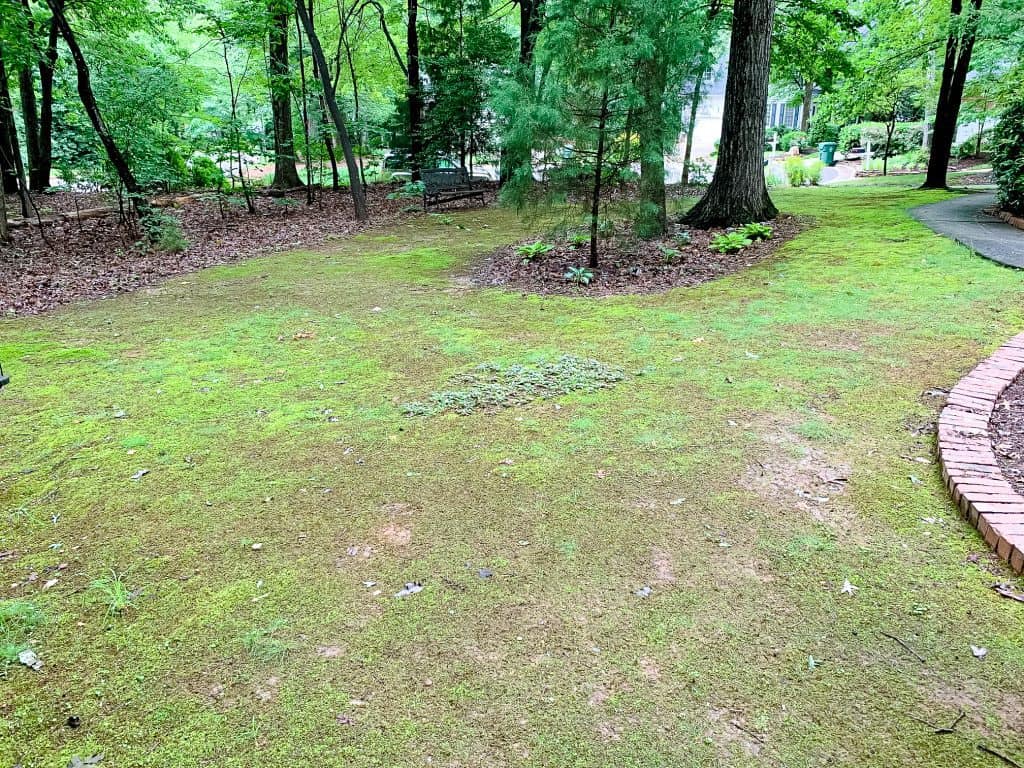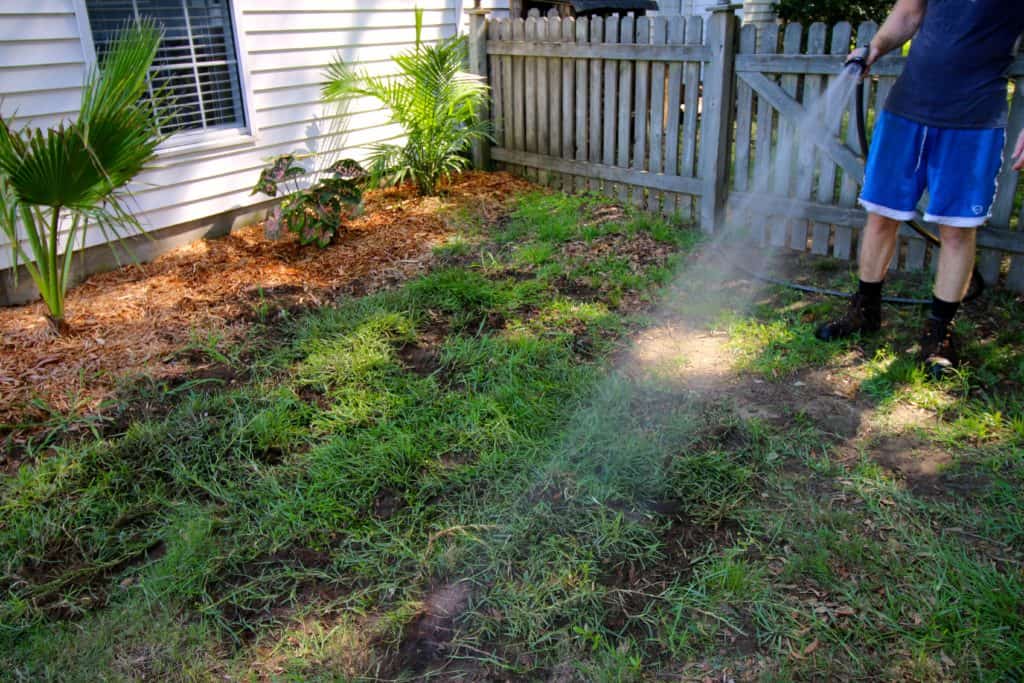Wondering how often to water your new grass seed? Here is everything you need to know!
Planting new grass can be nerve-wracking.
Whether your existing lawn is fine or a total dirt pile, you want to do anything you can to get your grass growing well and get a healthy lawn.
We know how hard it is to grow and maintain large areas of grass. If only mother nature would automatically give you a beautiful lawn!
We've shared a lot about grass in the past:
While exact specifications will vary based off of your soil type, the type of grass seed, and your climate, there are some best practices for best results when growing grass seed.
Today I want to talk about how to water new grass seed and some of the common questions that come up when doing so.
Here's the best way to water the grass on your new lawn!

How often to water new grass seed
Watering grass seed is a perfect balancing act.
Water too much and the roots can get soggy and rotten.
Don't water enough and they will dry up and not germinate or grow.
Typically, you want to water your grass two times per day - once in the early morning and once in the heat of the day.
For many people who work 9-5, this means once before work and then again in the early evening.
How much do I need to water my new grass?
The exact amount that you need to water your grass will vary depending on your soil type and climate.
You want the top few inches of soil to get and stay wet. Usually ten minutes of sprinkler time in each area of your lawn in sufficient to achieve that.
If it is very hot or very dry, you can water deeper and longer to be sure that your new seeds get enough water.
If you get a lot of rain, reduce the amount of watering that you do immediately following the storm. You don't want so much water that you get puddles!
Can new grass seed be overwatered?
Yes! overwatering your grass seed can lead to root rot. It also can cause the soil to compact and the grass will not grow well in that environment.
It's best to monitor your grass the first few times to determine the amount of time each area needs to be waterd.
Clay soils can pool up with puddles faster than sandy soils, for example.
It's a good idea to monitor for inches of water sitting on top of the soil and adjust your timing accordingly.

What time of day is the best time to water grass seed & seedlings?
In the early stages of your new lawn, it's important to water really consistently.
We have found that it's easiest to remember to water your new seed when you set up a watering schedule for yourself.
Generally you want to water first thing in the morning (between 6 and 10am) so the top few inches of soil are moist going into the day.
Then, you will want to water again at the hottest time of the day - usually early afternoon ideally - to make sure the grass seed is moist at all times.
Should you use a timer for your sprinklers?
Sprinkler systems with timers have the benefit of being able to water your seeding area even when you aren't home. This can be great if you work long hours or are out of the house a lot.
However, you want to be sure that you aren't over watering your yard and definitely that you don't run your sprinkler system while it's raining!
Having your grass seed sit under inches of water in puddles can lead to root rot and is not great for the seeds.
So, an irrigation system is great! Just be sure that you monitor it and use your human brain to get the robot working properly!

Other common new grass questions
Here are some other questions you might have about your new grass seedlings and lawn care.
What time of year is best for planting grass seed?
Generally you want to plant in late spring when the mild temperature will lead to good results.
If you live in a cooler climate, early summer might work.
The kind of seed you use will be impacted by the time of year, too. Some grass types are warm season grassed and some are cool season grasses.
This is effected by your weather conditions as well as the time of year.
How soon can I mow after planting new grass?
You want to wait until your grass is 3-4 inches tall before mowing it. This allows it to get established before cutting it.
We prefer to keep our lawn long in general. This means you have to mow more often - every weekend in the summer for us - but it helps it look thicker and more lush.
When can I use weed killer on my new grass?
You will want to consult the label on any weed killer products, but the general recommendation is to wait until your grass has been mowed at least 4 times that year before applying weed killers.
Do I need to be mulching new grass seed?
Mulching grass seed means spreading a thin layer of something over top of the seed.
The purpose of this is to hold in moisture and keep your grass seeds from drying out.
You can use actual mulch but you can also use:
- Saw dust
- Peat moss
- Straw
- Pine straw
- Compost
Don't use such a thick layer that your seed can't get sun. Keep it to ¼" or less, just enough to help it stay moist.
Layer the surface about halfway with "mulch", no more. This amount should not need to be raked up and will instead break down over time.
Do I need to water my lawn before I lay grass seed?
Consult your grass seed packaging, but most seeds suggest watering the ground so that 6-8 inches of dirt is fully saturated a few days before planting.
Grass seeds require staying moist and laying them on moist soil increases the chances of successful grass seed germination, or that the seeds will actually turn into green grass.
This amount of water will help set you up for success and improve the soil conditions for a successful germination process.
Also be sure to water all new grass seed for 5-10 minutes in each spot to make sure it is fully saturated.
How long does it take grass seed to grow?
Consult your packaging for your seeds' germination time, but you should usually have good growth in 3 to 28 days.
If that much time has passed without growth, your grass might not be growing.
How often do I water my grass once it is an established lawn?
Once your grass has been established, you only need to water it about twice per week. Water it deeply, for at least ten minutes in each spot.
This will be less water than the seeds need, but you still want to water either first thing in the morning or in the late afternoon. This will help to encourage deep root growth.
Try to avoid puddles of water as this can cause grass roots to rot!
Any more questions about watering your new grass and getting a lush green lawn?
Looking for something?
We've been doing this since 2012 so we have a LOT of blog posts!
Search stuff like: Ceiling Projects | DIY Plant Stands | Thrift Flips


Hello, I'm Morgan, half of the creative force behind CharlestonCrafted.com! With a passion for DIY that dates back to 2012, I've transformed three homes and now I'm dedicated to helping others craft their dream spaces. Let's turn your house into a home together!





